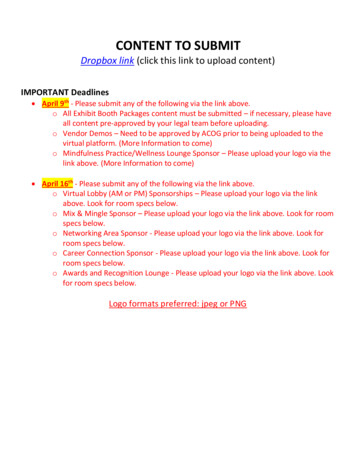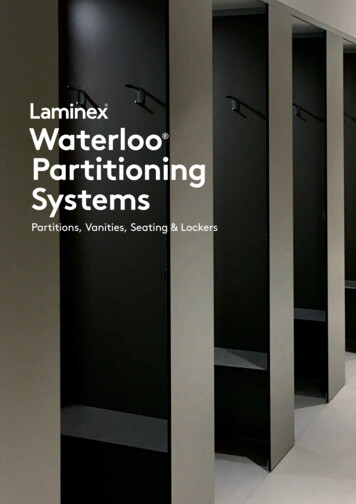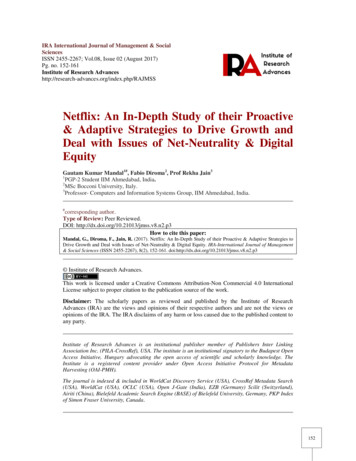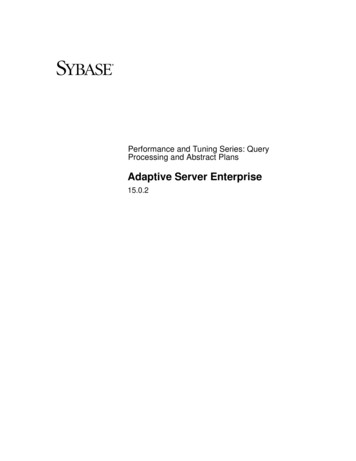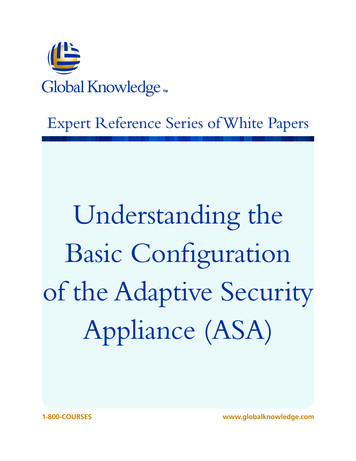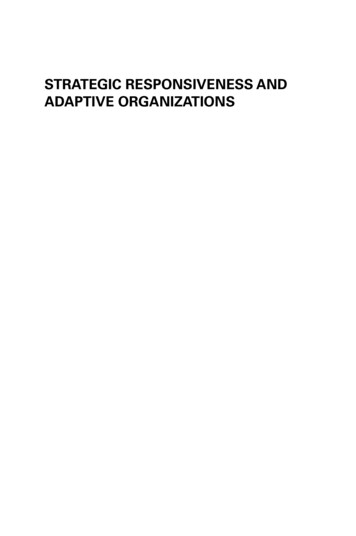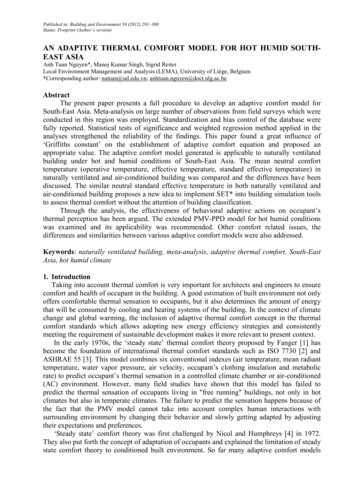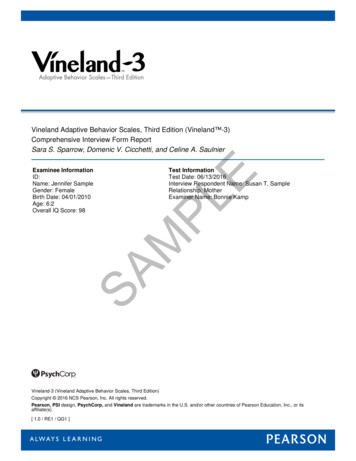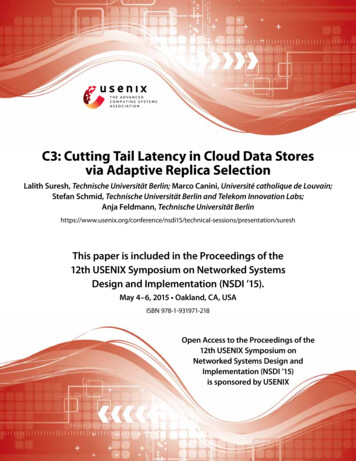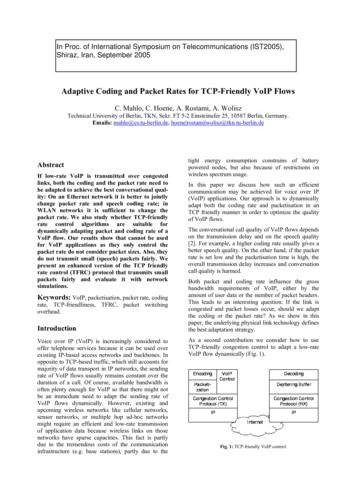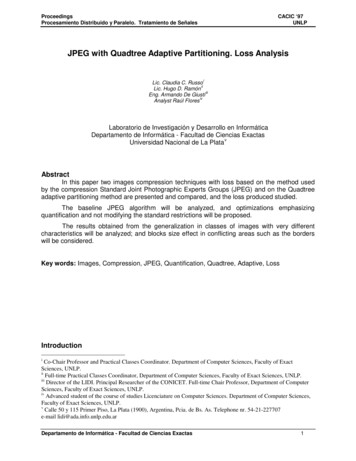
Transcription
ProceedingsProcesamiento Distribuido y Paralelo. Tratamiento de SeñalesCACIC ‘97UNLPJPEG with Quadtree Adaptive Partitioning. Loss AnalysisiLic. Claudia C. RussoiiLic. Hugo D. RamóniiiEng. Armando De GiustiivAnalyst Raúl FloresLaboratorio de Investigación y Desarrollo en InformáticaDepartamento de Informática - Facultad de Ciencias ExactasUniversidad Nacional de La Plata vAbstractIn this paper two images compression techniques with loss based on the method usedby the compression Standard Joint Photographic Experts Groups (JPEG) and on the Quadtreeadaptive partitioning method are presented and compared, and the loss produced studied.The baseline JPEG algorithm will be analyzed, and optimizations emphasizingquantification and not modifying the standard restrictions will be proposed.The results obtained from the generalization in classes of images with very differentcharacteristics will be analyzed; and blocks size effect in conflicting areas such as the borderswill be considered.Key words: Images, Compression, JPEG, Quantification, Quadtree, Adaptive, LossIntroductioniCo-Chair Professor and Practical Classes Coordinator. Department of Computer Sciences, Faculty of ExactSciences, UNLP.iiFull-time Practical Classes Coordinator, Department of Computer Sciences, Faculty of Exact Sciences, UNLP.iiiDirector of the LIDI. Principal Researcher of the CONICET. Full-time Chair Professor, Department of ComputerSciences, Faculty of Exact Sciences, UNLP.ivAdvanced student of the course of studies Licenciature on Computer Sciences. Department of Computer Sciences,Faculty of Exact Sciences, UNLP.vCalle 50 y 115 Primer Piso, La Plata (1900), Argentina, Pcia. de Bs. As. Telephone nr. 54-21-227707e-mail lidi@ada.info.unlp.edu.arDepartamento de Informática - Facultad de Ciencias Exactas1
ProceedingsProcesamiento Distribuido y Paralelo. Tratamiento de SeñalesCACIC ‘97UNLPJPEG is one of the best known Standards for images compression with loss. A goodcompression ratio is obtained when applying it on photographs, works of art, and similarmaterial, although it is not suitable for texts, simple drawings or lines. JPEG exploits the humanvisual system limitations. [Cla95] [Nels91].JPEG defines three different codification systems: A baseline codification system with loss, which uses as a base the Discrete CosineTransform (DCT) An extended codification system for applications requiring more accuracy,progressive reconstruction, etc. An independent codification system without loss for a reversible compression.In order to be JPEG-compatible, any product should include a support for the baselinesystem. The standard proposes a syntax to be satisfied by any bits sequence in order to beJPEG, allowing a large degree of freedom for the quantification and codification stages, so thatoptimizations and improvements can be carried out. No images format is specified, nor spatialresolution or any particular features as regards color. A useful characteristic of the method isthat loss degrees may be varied by adjusting compression parameters, which will be explainedlater.Baseline JPEG algorithm descriptionThe system recommended by JPEG is a modification of that proposed by Chen andPratt, and it is based on the codification technique using DCT. The compression process isdone in three sequential steps [Say96]: Transformation: The transform used is the DCT. Quantification: The uniform MIDTREAD quantification is used to quantify thecoefficients of a transformed block. Codification: The DC and AC coefficients resulting from the quantification arecodified using variable length codes.Generalization to fixed partitioningThe first implementation is a generalization to partition the image in fixed-size blocks(4x4, 8x8, 16x16, 32x32). Different quantification and codification tables are used: for fixedpartitioning with 8x8 blocks, the default quantification matrix was used, and the different losslevels were obtained by multiplying this matrix by an scalar or factor; the Huffman codificationtables for 8x8 blocks are those provided by the standard. For the other block sizes the followingquantification matrix was built: 1 (1 i j)*factor; 0 i, j NAlthough there are techniques to build adaptive quantification tables, the criterion used isthat coefficients generally decrease in importance from the upper left corner to the lower rightone. This is the reason why the matrix is built in a way so that the coefficients closest to the(0,0) position keep a greater accuracy when being dequantified.The Huffman codes tables were built by means of a run over different images, on whichdifferent loss degrees were applied. These runs allowed the extraction of symbols probabilities,which were chosen according to the block.Generalization Results and ObservationsThe VLSI.BMP image, which is a white-written formula on a black background, and fromwhich a 64x64 pixel sub-image belonging to the black color section was extracted, was used toDepartamento de Informática - Facultad de Ciencias Exactas2
ProceedingsProcesamiento Distribuido y Paralelo. Tratamiento de SeñalesCACIC ‘97UNLPcarry out the tests. The fixed size partitioning algorithm for the 4 types of blocks with factor 1was applied to this sub-image, and ratios of 18, 36, 55 and 65 were obtained for N 4, 8, 16and 32 respectively. These were kept unchanged in spite of making the factors vary, whereasthe decompressed images did not present changes in their black shade, at least visually. Thenthe same algorithm was applied to the original complete image and the following ratios wereobtained:N 4Factor Ratio26881810.42510.8N 8Factor Ratio213724927N 16Factor Ratio26611N 32Factor Ratio5139211023The best results as regards visual quality were obtained when processing 4x4 blocks,although compression ratios increased slower when applying factors greater than 18. As thetable shows, for factors 18 and 25 the difference in ratio is minimal and the quality of thedecompressed images is similar. With factors 7, 6 and 10 for 8x8, 16x16 and 32x32 blocksrespectively, the distortions in the area of the formula grew notorious. Even though a greatercompression was obtained with greater block size, visible distortions affecting black areas awayfrom the formula were produced.Quadtree PartitioningThis partitioning is used for images processing, and it attempts to overcome thedifficulties presented by the fixed partitioning. The basic algorithm consists on taking a squareblock of the image, which is then divided in four equally-sized, square sub-blocks. This isrecursively repeated from the complete original image until the squares reach the desired size,which is determined according to a decision test which depends on the application. The samepartitioning, but in a bottom up way, can be carried out, beginning the process with the smallersub-blocks and joining them to form bigger ones.Generalization using Quadtree partitioningQuadtree is used to adapt different areas of the image to a determined block size,according to its gray shades variation. Large areas with slow changes in their levels of detail aretreated with bigger blocks, and areas rich in details are treated with smaller ones.This implementation is based on a scheme proposed by Chen (1989), where the imageis divided into initial 32x32 blocks, which are in turn completely partitioned up to 4x4 blocks. Atest is applied on 4 brother 4x4 sub-blocks to determine if these will be individually processed orif they can be joined to form a possible 8x8 block. The same process is done for each 4 8x8 and16x16 brother blocks.The test is of the following kind: if abs(Mk(i)-Mk(j)) Tk for any i jProcess the 4 sub-blocks individually;ElseJoin the sub-blocks and mark them as a possible bigger one;The terms Mk(i) and Mk(j) (i,j 1.4) represent averages of gray shades of brother blocksin the kth level of the tree, and Tk is the decision limit. The idea is that, in order to determine howactive an NxN area is, we divide it into 4 equally-sized blocks, find their averages and see howsimilar they are. If there is no averages pair whose difference is greater than a pre-establishedDepartamento de Informática - Facultad de Ciencias Exactas3
ProceedingsProcesamiento Distribuido y Paralelo. Tratamiento de SeñalesCACIC ‘97UNLPlimit, then we consider the NxN area as not very active (a suggested limit is 10 for 8 bitsimages), and we process it as a single block. In case the difference is greater than the limit, wesplit it.To represent header information we only need transmit one bit for each sub-block,indicating whether it is to be partitioned or not. Thus, in the worst of cases we will codify 21 bitsfor each 32x32 block, which is equivalent to a cost of 0.02 bits per pixel. According to the size ofeach sub-block of the final partitioning (4x4, 8x8, 16x16 or 32x32), processing is similar to thatapplied by JPEG to each 8x8 block. The difference lies in the fact that the DC coefficient iscodified as regards the same element of the previous block only if both blocks are of the samesize. If the previous block is of a different size, then the same value of the quantified coefficientis codified.Loss factors can be varied for the different block sizes according to the quality leveldesired for the different areas. For example, if one wishes to increase the loss in very activeareas, the most convenient step to follow is to increase the loss factor for smaller blocks, since itis to be expected that these block sizes will fall into these areas. Similarly, if one wishes todecrease image quality in large, not very active areas, factors for bigger blocks should beadjusted.In general, not very active areas belong to the background of the image, and willconsequently be processed with larger blocks (32x32, 16x16).Three examples of sequences of steps to be followed to partition a 32x32 blockImage partitioned with limits of 20,20,20Hat blockMirror blockDepartamento de Informática - Facultad de Ciencias Exactas4
ProceedingsProcesamiento Distribuido y Paralelo. Tratamiento de SeñalesCACIC ‘97UNLPShoulder blade blockIn short, this compression technique has the following parameters which can beadjusted: Decision limit to decide whether to partition an 8x8, 16x16, 32x32 block or not; lossfactor for 4x4, 8x8, 16x16 and 32x32 blocks.Observations and some results of the adaptive methodDue to space limitations, we only analyze the results of two images with very differentcharacteristics in this article. The results obtained from the VLSI.BMP and LENA.BMP imagescorrespond to a partitioning of 10 and 20 respectively for each of the three limits.For the first image partitioning, the areas with the formula were treated with smallerblocks (4x4 and 8x8), whereas most of the dark area was processed with 32x32 blocks, andwith fewer 16x16 ones. With this block distribution, distortions were detected only in areas veryclose to the formula, and only when applying very high factors. The following tables show someof the results obtained for the images.Even though the value of the loss factors can be increased for 8x8, 16x16 and 32x32blocks without a visible distortion for the areas where they fall, these increments are notreflected in the size of the compressed images.Table for VLSI.BMPDecompressedRatiopv1 1.bmppv1 2.bmppv1 3.bmppv1 4.bmppv1 5.bmppv1 6.bmppv1 7.bmp6.49.99.98111314.414.5Ratio Factor4x429915202525Ratio Factor8x82299999Ratio Factor16x162222229Ratio Factor32x322222229Table for LENA.BMP (with values of 20 for partitioning decision limits)DecompressedRatioplena4 1.bmpplena4 2.bmpplena4 3.bmpplena4 4.bmpplena4 5.bmpplena4 6.bmpplena4 7.bmpplena4 7.bmp48.36.4910.811.1811.413.16Ratio Factor4x42951015151520Ratio Factor8x822332344Ratio Factor16x162951015151515Departamento de Informática - Facultad de Ciencias ExactasRatio Factor32x3229510151515155
ProceedingsProcesamiento Distribuido y Paralelo. Tratamiento de Señalesplena4 7.bmp13.320515CACIC ‘97UNLP15plena4 1.bmpplena4 5.bmpplena4 9.bmpThe following pictures show the loss produced as the difference between the originalimage and the compressed one:Plena4 1.bmp errorPlena4 5.bmp errorDepartamento de Informática - Facultad de Ciencias ExactasPlena4 9.bmp error6
ProceedingsProcesamiento Distribuido y Paralelo. Tratamiento de SeñalesCACIC ‘97UNLPFidelity criteriaA natural thing to do when we are interested in the fidelity of a reconstructed sequence isto observe the differences between the original and the reconstructed values - that is, thedistortion introduced during the compression process. Mean squared error and absolutedifference are two well known ways of measuring the distortion or difference between theoriginal and the reconstructed sequences. They are called distortion difference measures.If {xn} is the font output and {yn} is the reconstructed sequence, then the square errormeasure is the following:d ( x, y) ( x y) 2whereas the absolute difference measure is given by:d ( x , y ) x y It is generally difficult to examine the difference on a term by term basis. Therefore, tosummarize the information in the differences sequence, a set of measures of the average isused.The most commonly used average measure is the square errors average, called meansquared error.σ2 1 N2 ( xn yn)N n 1If we are interested in the error size in relation to the signal, we can find the font outputaverage square value of the ratio and the mse, which is called signal-to-noise (SNR):SNR σ 2xσ d2The SNR is frequently measured in a logarithmic scale, its measurement unit being the decibel(dB):SNR(dB) 10 log 10σ 2xσ d2Some times we are interested in the error size relative to the signal maximum value. Thisratio is called peak signal to noise ratio (PSNR), and is given byPSNR (dB) 10 log 10 X2 peakσ d2Other widely used measure of distortion difference - although not as used as the mse - isthe absolute difference average:4x4 lenf23.bmplenf24.bmp11,2725,0638,5
partitioning, but in a bottom up way, can be carried out, beginning the process with the smaller sub-blocks and joining them to form bigger ones. Generalization using Quadtree partitioning. Quadtree is used to adapt different areas of the image to a determined block size, according to its gray shades variation. Large areas with slow changes in their levels of detail are treated with bigger .
